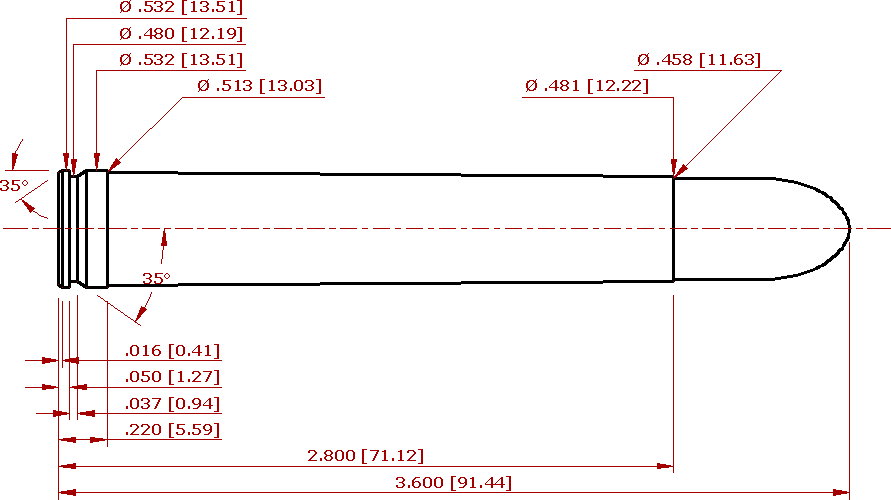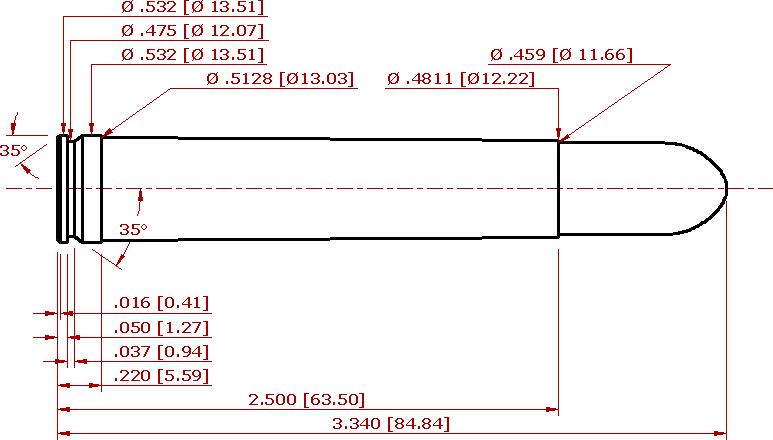|
Weatherby Mark V
The Weatherby Mark V is a centerfire, bolt-action rifle manufactured by Weatherby of Sheridan, Wyoming. The rifle was introduced in 1957 by Weatherby and was designed to safely contain the high pressures associated with the Weatherby line of high performance cartridges. It is the flagship rifle of the Weatherby line of firearms. The Weatherby Mark V rifles are considered prestigious or luxury firearms by many. This is due in part to Roy Weatherby who presented the rifles to royalty, politicians, gun writers and actors including Prince Abdorreza Pahlavi of Iran, Generals James Doolittle (USAF) and Chuck Yeager (USAF), Jack O'Connor, Warren Page, Elgin Gates and Lorne Greene and was able to use this fact as a marketing tool. Early development Ever since Roy Weatherby began manufacturing rifles he had to rely on a third party to provide the actions for his rifles. Beginning in 1949 Weatherby began building his rifles around the FN Belgian Mauser action. In 1955 Schultz & Larson a ... [...More Info...] [...Related Items...] OR: [Wikipedia] [Google] [Baidu] |
Roy Weatherby
Roy Edward Weatherby (4 September 1910 — 4 April 1988), was the founder and owner of Weatherby, Weatherby, Inc., an American rifle, shotgun and cartridge manufacturing company founded 1945. Weatherby created an entire line of custom cartridges, and was one of the people responsible for the industry interest in high-speed cartridges. He created a custom rifle action to accommodate his high-pressure cartridges. History He grew up on a farm in Kansas. He later moved to Huntington Park, California where he and his wife, Camilla, bought a Spanish style home located on 7672 California Street on the corner of Grand Avenue. Weatherby started manufacturing Weatherby Guns in his garage at the Huntington Park home. Weatherby firearms are best known for their very high-powered rifle cartridges, all bearing the name Weatherby#Calibers, Weatherby Magnum such as the .257 Weatherby Magnum (designed in 1944), the .378 Weatherby Magnum (1953) and the .460 Weatherby Magnum (1957), and for the pr ... [...More Info...] [...Related Items...] OR: [Wikipedia] [Google] [Baidu] |
Bolt-action
Bolt-action is a type of manual firearm action that is operated by ''directly'' manipulating the bolt via a bolt handle, which is most commonly placed on the right-hand side of the weapon (as most users are right-handed). Most bolt-action firearms use a rotating bolt design, where the handle must first be rotated upward to unlock the bolt from the receiver, then pulled back to open the breech and allowing any spent cartridge case to be extracted and ejected. This also cocks the striker within the bolt (either on opening or closing of the bolt depending on the gun design) and engages it against the sear. When the bolt is returned to the forward position, a new cartridge (if available) is pushed out of the magazine and into the barrel chamber, and finally the breech is closed tight by rotating the handle down so the bolt head relocks on the receiver. Bolt-action firearms are generally repeating firearms, but some single-shot breechloaders also use bolt-action design as ... [...More Info...] [...Related Items...] OR: [Wikipedia] [Google] [Baidu] |
458 Lott
The .458 Lott is a .458 caliber rifle cartridge designed for the purpose of hunting large, thick-skinned dangerous game animals in Africa. It is based on the full length .375 H&H Magnum case blown out and shortened to . The .458 Lott was designed in response to perceived inadequacies and problems encountered with the .458 Winchester Magnum. The cartridge provides a distinct step up in performance over the .458 Winchester Magnum. A-Square, Česká Zbrojovka/Brno, Hornady, and Ruger have been instrumental in the cartridge's rise in popularity. Cartridge history The .458 Winchester Magnum was designed in 1956 and was an immediate commercial success. It was a more economical alternative to the English double rifles that were considered the standard rifle type for dangerous game hunting in Africa. The .458 Winchester Magnum was designed to emulate the performance of the .450 Nitro Express in a standard-length bolt-action rifle. However, it soon became apparent that the .458 Winch ... [...More Info...] [...Related Items...] OR: [Wikipedia] [Google] [Baidu] |
458 Winchester Magnum
The .458 Winchester Magnum is a belted, straight-taper cased, big five game rifle cartridge. It was introduced commercially in 1956 by Winchester and first chambered in the Winchester Model 70 African rifle. It was designed to compete against the .450 Nitro Express and the .470 Nitro Express cartridges used in big bore British double rifles. The .458 Winchester Magnum remains one of the most popular large game cartridges, and most major ammunition manufacturers offer a selection of .458 ammunition. History The .458 Winchester Magnum was designed for hunting dangerous game animals by emulating the performance of powerful English double rifle cartridges in a bolt-action rifle. The use of a bolt-action rifle offered hunters a cheaper alternative to the big-bore double rifle, and ammunition could be manufactured using available tooling. The .458 Winchester Magnum soon became a success as dangerous game hunters adopted the cartridge. Soon game wardens, wildlife managers, and profes ... [...More Info...] [...Related Items...] OR: [Wikipedia] [Google] [Baidu] |
416 Remington Magnum
The .416 Remington Magnum is a .416 caliber (10.57 mm) cartridge of belted bottlenecked design. The cartridge was intended as a dangerous game hunting cartridge and released to the public in 1989. The cartridge uses the case of the 8 mm Remington Magnum as a parent cartridge. When the cartridge was released in 1988, author Frank C. Barnes considered the .416 Remington Magnum to be the "most outstanding factory cartridge introduced in decades". The cartridge was conceived as a less costly alternative to the .416 Rigby cartridge and was intended to replace the latter. While today the .416 Remington Magnum is considered in the field the most popular of the .416 cartridges, the .416 Remington did not replace the .416 Rigby as had been anticipated. Rather, it sparked a renewed interest in the .416 caliber (10.57 mm) cartridges which led to the revival of the .416 Rigby and the introduction of other .416 cartridges such as the .416 Weatherby Magnum and the .416 Ruger. The . ... [...More Info...] [...Related Items...] OR: [Wikipedia] [Google] [Baidu] |
375 H&H Magnum
__NOTOC__ Year 375 ( CCCLXXV) was a common year starting on Thursday (link will display the full calendar) of the Julian calendar. At the time, it was known as the Year after the Consulship of Augustus and Equitius (or, less frequently, year 1128 ''Ab urbe condita''). The denomination 375 for this year has been used since the early medieval period, when the Anno Domini calendar era became the prevalent method in Europe for naming years. Events By place Roman Empire * November 17 – Emperor Valentinian I concludes an enduring peace with the Alamanni in Germany, then marches into Illyricum to repel an invasion of the Quadi and the Sarmatians on the Danube frontier. While negotiating with the Quadi, Valentinian, age 54, becomes so enraged that he dies in a fit of apoplexy at Brigetio (Hungary). Extreme cruelty has marked his 11-year reign, but he has also founded schools and provided physicians to serve the poor of Constantinople. * The Quadi accept an uneasy p ... [...More Info...] [...Related Items...] OR: [Wikipedia] [Google] [Baidu] |
338 Winchester Magnum
__NOTOC__ Year 338 ( CCCXXXVIII) was a common year starting on Sunday (link will display the full calendar) of the Julian calendar. At the time, it was known as the Year of the Consulship of Ursus and Polemius (or, less frequently, year 1091 ''Ab urbe condita''). The denomination 338 for this year has been used since the early medieval period, when the Anno Domini calendar era became the prevalent method in Europe for naming years. Events By place Roman Empire * The Romans, allied with the Goths, arrive in the north of the Roman Empire to protect the Danube frontier. * Emperor Constantius II intervenes against the Persians in Armenia. Persia * Shapur II, king of the Persian Empire, begins a widespread persecution of Christians. He orders forcible conversions to the state religion, Zoroastrianism, lest the Christians disrupt his realm while he is away fighting the Romans in Armenia and Mesopotamia. Asia * Tuoba Yihuai, ruler of the Tuoba Dai clan, dies and is succ ... [...More Info...] [...Related Items...] OR: [Wikipedia] [Google] [Baidu] |
300 Winchester Magnum
The .300 Winchester Magnum (also known as .300 Win Mag or .300 WM) (7.62×67mmB, 7.62x66BR) is a belted, bottlenecked magnum rifle cartridge that was introduced by the Winchester Repeating Arms Company in 1963. The .300 Winchester Magnum is a magnum cartridge designed to fit in a standard rifle action. It is based on the .375 H&H Magnum, which has been blown out, shortened, and necked down to accept a .30 caliber (7.82 mm) bullet.2002, ''Lyman Reloading Handbook, 48th Edition'' The .300 Win Mag is extremely versatile and has been adopted by a wide range of users including big game hunters, target shooters, military units, and law enforcement departments. Many hunters have found the cartridge to be an effective all-around choice with bullet options ranging from the flatter shooting 150 grain to the harder-hitting 200+ grain selections available in factory ammunition. The .300 Win Mag remains the most popular .30 caliber magnum with American hunters, despite being surpasse ... [...More Info...] [...Related Items...] OR: [Wikipedia] [Google] [Baidu] |
30-06 Springfield
The .30-06 Springfield cartridge (pronounced "thirty-aught-six" ), 7.62×63mm in metric notation, and called the .30 Gov't '06 by Winchester, was introduced to the United States Army in 1906 and later standardized; it remained in military use until the late 1970s. The ".30" refers to the caliber of the bullet in inches. The "06" refers to the year the cartridge was adopted, 1906. It replaced the .30-03, 6mm Lee Navy, and .30-40 Krag cartridges. The .30-06 remained the U.S. Army's primary rifle and machine gun cartridge for nearly 50 years before being replaced by the 7.62×51mm NATO and 5.56×45mm NATO, both of which remain in current U.S. and NATO service. It remains a very popular sporting round, with ammunition produced by all major manufacturers. History In the early-1890s, the U.S. military adopted the smokeless powder .30-40 Krag rimmed cartridge. The 1894 version of that cartridge used a round-nose bullet. Around 1901, the U.S. started developing an experimental rimles ... [...More Info...] [...Related Items...] OR: [Wikipedia] [Google] [Baidu] |
308 Winchester
The .308 Winchester is a smokeless powder rimless bottlenecked rifle cartridge widely used for hunting, target shooting, police, military, and personal protection applications globally. It is similar but not identical to the 7.62×51mm NATO cartridge. History During the 1940s, the .300 Savage became the basis for experiments on behalf of the U.S. military that resulted in the development of the T65 series of experimental cartridges. The original experimental case design by the Frankford Arsenal was designated the T65 and was similar to the .300 Savage case, but with less taper. The experimental cases were made from standard .30-06 Springfield cases which gave a little less capacity than standard .300 Savage cases because the Frankford Arsenal cases had slightly thicker case walls. The later T65 iterations were lengthened compared to the original T65 case and provided a ballistic performance roughly equal to the U.S. military .30-06 Springfield service cartridge. Over forty yea ... [...More Info...] [...Related Items...] OR: [Wikipedia] [Google] [Baidu] |







